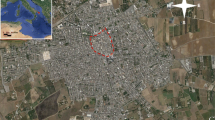Abstract
Brasilia, the capital city of Brazil, is located in the central region of the country. Climate in the area is semitropical with an annual rainfall of 1500 mm. The geological environment in the area consists of low-grade metamorphic rocks. Slates of varying colors, metasiltstone, and quartzite beds are present. Over the Precambrian rocks is a lateritic layer varying in thickness from centimeters up to 30 m. Latosol dominates the existing plateaus, while laterite crusts and immature soils are dominant in the transition zones between plateaus and river valleys. Erosional problems related to the lateritic terrains were known prior to the settlement of the city in 1961. During 1986, erosion became a serious threat when several pseudosinkholes occurred in the urban area. Occurrence of pseudosinkholes resulted in condemnation of an area of 300,000 m2 and the demolition of several buildings. Preliminary studies indicated at the time that underground erosion and pseudosinkholes were generated by shortening of the percolation path of groundwater due to the progress, toward the residential area, of large gullies. This produced an increase in the hydraulic gradient, resulting in the removal of latosol particles. Occurrence of pseudosinkholes in other areas of the city has led the Institute of Geosciences to investigate the problem in more detail. Studies have been conducted looking for correlation between pseudosinkhole occurrence and geologic, geomorphic, geotechnical, and urban development features. Recent results show a much more complex process then previously thought. Field data suggests that termite activity and recharge of the water table by inadequate disposal of residential sewer systems are directly related to the problem.
Similar content being viewed by others
References
Barros JGC (1990) Caracteristicas geológicas e hidrogeológicas do Distrito Federal. In: Novaes M (Ed), Cerrado, Caracterização, Ocupaçâo e Perspectiva: O caso do DF. Brasilia, DF: UNB/ SEMATEC
Belcher DJ and Associates (1956) Relatório técnico sobre a nova Capital da República, 2nd ed. CODEPLAN
Buosi MA and Cadman JD (1984) Sobre a ocorrência de cavidades tubulares em solos lateriticos na região Amazônica. 4th Congresso Brasileiro de Geologia de Engenharia
Farias M (1989) O Grupo Paranoá no Distrito Federal. In: Simpósio de Geologia de Minas Gerais, 5. Belo Horizonte: Anais SBG/MG
Lafleur RG (1984) Ground-water as a geomorphic agent. Boston: Allen & Unwin
Newton JG (1987) Development of sinkholes resulting from man's activities in eastern United States. US Geological Survey Circular 968
Oliveira Filho AT and Furley PA (1990) Moncho, Cocurutu, Murundum. Cien Hoje 11(6): 30–37
Pinto MN (1986) Superficies de aplainamento do Distrito Federal. Rev Bras Geogr 49(2): 9–26




